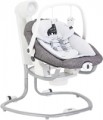Type
— Rocker. The distinctive feature of rockers as a type of swings is the adjustable backrest, which can be raised from lying to sitting position. The seat itself can be either adjustable or non-adjustable in tilt, but in any case the backrest and seat are adjusted separately. Rocker models can be used both for newborns and for older babies who are able to sit up on their own.
—
Bouncer. Chair bouncers differ first of all in that they do not have an adjustable backrest: only the tilt angle of the whole unit (backrest+seat) can be changed, and the unit itself is designed for lying down position of the child only. Thanks to the latter, all bouncers can be used from the first days of the baby's life; on the other hand, when the baby grows up and can sit up independently, the bouncer may not be so convenient.
—
Swing. Designs similar to classic children's swings: the seat unit is attached to a fixed stand and can swing back and forth thanks to movable fasteners (unlike other types that swing on curved skids, like classic rocking chairs). The advantage of the swing is the immobility of the base — they can be placed on any surface without fear of damaging it. On the other hand, swings take up significantly more space than other types. At the same time, there are models in which the seat unit can be removed and used separately as a rocking chair or bouncer (see above).
Speeds of rocking
The number of different speeds at which the automatic rocking system (see above) can rock the swing. The more speeds, the more accurately you can choose the most pleasant option for your baby.
Harness type
— Three-point. The classic version has three harnesses, one between the child's legs and two in the waist area, which come together in a buckle on the abdomen; the design may vary, but the principle of fixation (from below and around the waist) is always the same. In general, such harnesses provide a medium degree of safety, and in most cases they are sufficient.
— Five-point. In fact, it is a three-point system (see above), supplemented by a pair of harnesses running to the abdomen through the shoulders. This system provides the highest degree of safety available today.
Carrying handles
Special
handles that make it easier to carry the swing. Usually they are fabric straps — they are quite comfortable and take up a minimum of space when not in use.
More features
—
Timer. A timer that switches off the automatic rocking mechanism (refer to "Automatic rocking") after a certain time. Thus, knowing the approximate time your baby falls asleep, you can set the timer and not worry about the rocker continuing to rock unnecessarily while your baby sleeps.
—
Removable table. The presence of a removable table top in the design of the swing. Such a swing can play the role of a high chair; in addition, the table top can be useful for games.
—
Player connection. A function similar to a music box (see above) — with the difference that the sound source is not the memory of the box itself, but a player connected to the swing.
—
Vibration unit. The mechanism that provides the vibration of the seat unit — this plays the role of a massage for the child, and also creates a relaxing effect.
—
Arc with toys. A structure in the form of an arc or bracket above a swing, on which various toys are suspended. They can be used to play or to distract the baby (for example, to stop crying). The arcs are often made removable, and the brackets are also swivel.
— Lighting effects. Multi-coloured flashing lights that can cheer up or distract the baby (especially in combination with sound).

